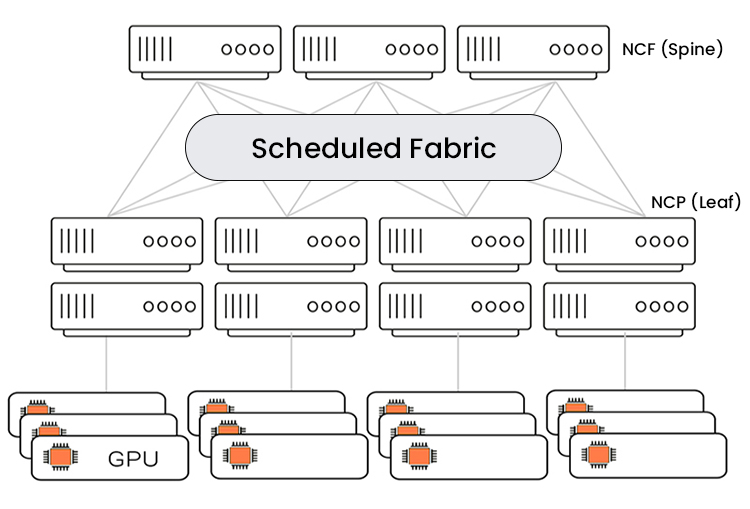Dazed by the acronyms?
This may help understand some key terms:
- DDC – Distributed Disaggregated Chassis
- AT&T – America’s largest telco (name derived from former American Telephone and Telegraph Company)
- OCP – Open Compute Project
- DNOS – DriveNets Network Operating System
- CSP – Communication Service Provider
- AI – Artificial Intelligence
- DSF – Distributed Scheduled Fabric
OK, still a bit confused even without the acronyms? Read on…
A bit of history about Distributed Disaggregated Chassis
DDC was defined and built as a joint operation led by AT&T with the support of several vendors – including DriveNets as the leading software (SW) vendor. The purpose was to build a large core router and indeed this was successfully concluded; it has been in operation by AT&T for several years throughout America.
DDC has since further evolved with its v2 and v3 specifications. These versions added more use cases within the telecom space and more device types that serve the varying use cases in a better way.
Besides AT&T, DDC is in use by other CSPs, and is considered a valid and leading solution of a disaggregated network. Besides DriveNets Network Cloud, other SW vendors like Cisco have implemented and deployed DDC. Besides core, other use cases like peering and aggregation have reached maturity and been commercially deployed by several operators.
So yes, DDC is a flexible architecture and AT&T is leading the way into expanding its use cases and ecosystem. So evolution into the next stage should be trivial, right? Read on…
The arrival of AI to data centers
Data center networking is king within OCP, and DDC was defined as an OCP standard. As such, DDC should be a classic fit for evolving from a service provider product to a data center product.
Data centers are rapidly being taken over with AI-purposed installations, which is triggering much discussion around the AI network within the OCP networking group. DDC is defined under the OCP telco group, which is kind of a stepson of OCP.
For DDC to make its way into the mainstream of data center AI networking, it needed an industry champion that wasn’t a telco player. For a data center player to promote this solution as its own, the DDC name would not work.

Best fit for AI Networking: Distributed Scheduled Fabric (DSF)
A distributed scheduled fabric is not a bad description of what DDC is all about. It highlights a strong attribute that’s crucial for AI networking and hides that this is, in fact, a chassis broken into its components. Not that there’s anything wrong with that, but it doesn’t highlight why it fits so well for AI networking.
What industry solutions are next for AI Networking?
The group of vendors taking part in the distributed/disaggregated scheduled fabric ecosystem is expanding with SW and HW vendors as well as hyperscalers accepting such solutions into their AI data center deployments. There are multiple industry data center leaders championing this solution into AI networking. While I don’t want to give credit to anyone explicitly, you can find these companies among the steering members of the Ultra Ethernet Consortium.
Meanwhile, DriveNets has launched the DriveNets Network Cloud-AI solution, which is derived from DriveNets’ DDC architecture deployed into AT&T’s core network about five years ago.
The tech world sometimes (maybe “always” is the better word) diverts from pure technology evolution into politics-dictated trajectories. This is not necessarily a good thing or a bad thing. It’s just something you need to realize to clear out a lot of the confusion.
Making scheduled fabric more easily consumable with DriveNets
DriveNets Network Cloud-AI solution is a new product based on DDC architecture. It implements a distributed scheduled fabric with some added features to make it more easily consumable for customers in the data center space. The solution is reliable, robust, high-performance, secured and manageable, just like any other telco space core router. Oh, and it’s also field-proven at the largest CSP network in the world.
Hope this helps clear away some of the confusion…
FAQs for AI Networking
- Who defined the DDC model?
DDC was defined and built as a joint operation led by AT&T with the support of several vendors – including DriveNets as the leading software (SW) vendor. - What other vendors have implemented DDC?
Besides DriveNets Network Cloud, other SW vendors like Cisco have implemented and deployed DDC. Besides core, other use cases like peering and aggregation have reached maturity and been commercially deployed by several operators. - What parts of the industry are pushing for a distributed/disaggregated solution for AI?
There are multiple industry data center leaders championing this solution into AI networking and these companies among the steering members of the Ultra Ethernet Consortium.
Additional Resources for AI Networking
Download white paper
5 Reasons You Should Include Network Disaggregation in Your Next Network RFP




